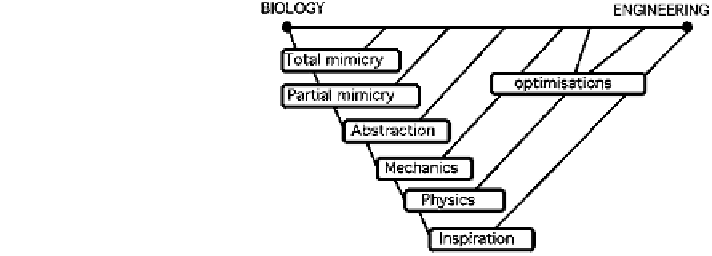Environmental Engineering Reference
In-Depth Information
Fig. 10.2 Biomimetics
''map'' (Vincent
2001
)
adaptable structural form. From a sustainability perspective, engineers were also
trying to rediscover intelligent features of trees, such as the ability to self-adapt, be
self-controlled, and be energy efficient, which leads to some interesting sustainable
designs. Vincent (
2001
) developed a biomimetic ''map'' to clarify the transfer
from biology to engineering, as shown in Fig.
10.2
.
The more one can move further down from the natural origin (top left), the
more powerful the concept will be. It illustrates that inspiration from biology at
the top level can be more adaptable within the engineering discipline, even though
the final product may vary far away from the prototype founded in nature. There
are many versions of this diagram which could be drawn for any engineering
design problems.
For structural design, some engineers may claim with buildings and bridges as
large-scale man-made structures, it is difficult to reach the efficiency as biological
creatures. However, many engineers have been sparked by the bio-inspired phi-
losophy and are dedicated to the development of bridges in future generations.
After simply borrowing geometrical feature from nature for centuries, recent
efforts in bridge design and construction by both architects and engineers have
shown inspiration from the mechanistic and the material level. Table
10.2
shows
many recently built bridge projects with a varied level of inspiration from different
aspects in the nature. Most designs are still within the low level of inspiration (total
mimicry, partial mimicry, and abstraction), sometimes resulting in many awkward
shapes rather than efficient structural forms. Fewer designs featured a high-level of
inspiration, in which design problems are addressed by biomimetics. A logical
explanation is that those engineers are aware of bio-inspired idea, but they are not
capable of finding tangible resources that could revolutionize their designs.
10.2.1 Stationary Forms
Traditionally, bridge design is still a classical static problem searching for efficient
forms across existing roads and rivers. The best bridge design in history has been
regarded as structural art, because it shows very good balance on economy, effi-
ciency, and elegance (Billington
1983
).

Search WWH ::

Custom Search